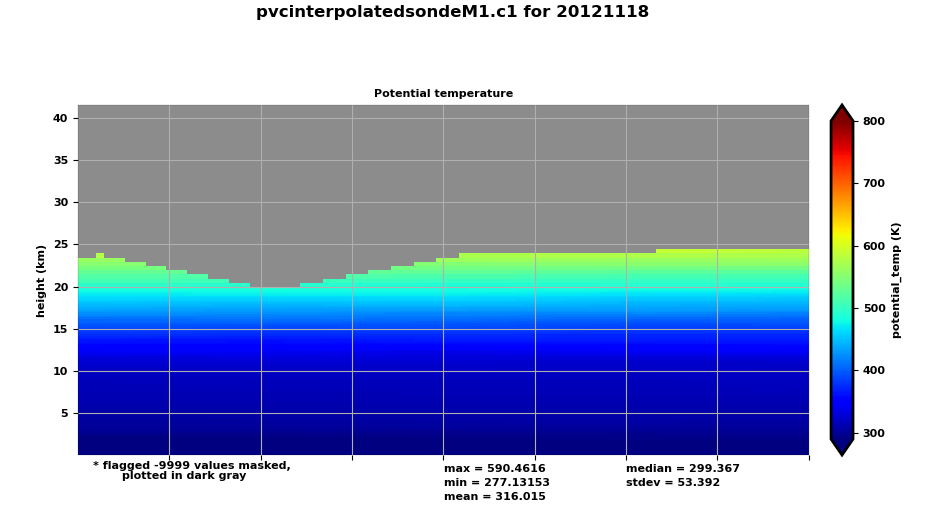New Cloud Microphysics and Sonde Products Available for 2 ARM Campaigns
Published: 17 July 2023

The Atmospheric Radiation Measurement (ARM) user facility released two new cloud microphysics and sonde value-added products (VAPs) from the 2012–2013 Two-Column Aerosol Project (TCAP) on Cape Cod, Massachusetts, and the Green Ocean Amazon (GoAmazon2014/15) field campaign near Manaus, Brazil.
The Interpolated Sonde (INTERPSONDE) VAP and W-Band Improved MICROBASE Product with Uncertainties (MICROBASEW) are now available for both campaigns.
INTERPSONDE transforms sounding data from weather balloon (sonde) launches into continuous daily files on a fixed time-height grid. Standard ARM sounding files provide atmospheric state data in one dimension of increasing time and height per sonde launch. Many applications require a quick estimate of the atmospheric state at higher time resolution.
To address this need, INTERPSONDE is available at 1-minute resolution, and the grid extends from the surface to 332 levels (40 kilometers) to capture the full height of soundings. (Most soundings end between 25 and 30 kilometers, above which no data are provided.) Between soundings, the VAP linearly interpolates atmospheric state variables at each height level.
In addition, INTERPSONDE data provide relative humidity scaled to microwave radiometer observations.

MICROBASEW is an evaluation product that provides continuous, high-temporal-resolution profiles of cloud microphysical properties such as the liquid/ice water content and liquid/ice effective radius. The VAP was primarily developed for estimating radiative heating rate profiles, but scientists can use it for diverse applications, including evaluation of model cloud parameterizations, process studies of precipitation formation, and cloud particle phase partitioning.
MICROBASEW uses parameterizations identical to those used by ARM’s historical Continuous Baseline Microphysical Retrieval (MICROBASE) VAP for determining the liquid/ice water content and liquid/ice effective radius. However, MICROBASEW adds uncertainties to these quantities using a perturbation method first applied through the Atmospheric System Research (ASR) Quantifying Uncertainty in Cloud Retrievals (QUICR) science focus group (Zhao et al. 2014).
To determine the cloud microphysical properties, MICROBASEW uses a combination of data from INTERPSONDE, the W-Band Cloud Radar Active Remote Sensing of CLouds (WACRARSCL) VAP, and the Microwave Radiometer Retrievals (MWRRET) VAP.
The MICROBASEW product is archived as daily data files. These files have a time resolution of 4 seconds and vertical resolution of 30 meters to 18,010 meters, which is consistent with the WACRARSCL data resolution.
MICROBASEW evaluation data are available for TCAP from October 12, 2012, to May 20, 2013, and for GoAmazon from February 18, 2014, to November 30, 2015.
INTERPSONDE production data are available for TCAP from July 1, 2012, to June 29, 2013, and for GoAmazon from January 1, 2014, to November 30, 2015.
More information about the VAPs can be found on the web pages for INTERPSONDE and improved MICROBASE products.
To ask questions, provide feedback, or report data problems for either VAP, please contact VAP developer Aifang Zhou or ARM translator Scott Giangrande. Feedback on MICROBASEW is especially encouraged to help improve the evaluation data.
Access the data sets for INTERPSONDE and MICROBASEW in the ARM Data Center. (Go here to create an account to download the data.)
INTERPSONDE data can be referenced as doi:10.5439/1095316. To cite the MICROBASEW data, please use doi:10.5439/1860939.
Reference: Zhao C, S Xie, X Chen, MP Jensen, and M Dunn. 2014. “Quantifying uncertainties of cloud microphysical property retrievals with a perturbation method.” Journal of Geophysical Research: Atmospheres, 119(9), https://doi.org/10.1002/2013jd021112
Keep up with the Atmospheric Observer
Updates on ARM news, events, and opportunities delivered to your inbox
ARM User Profile
ARM welcomes users from all institutions and nations. A free ARM user account is needed to access ARM data.


















